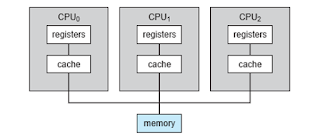Computer-System
Structure:
1. Single-Processor System : On a single processor system, there is
one main CPU capable of executing a general-purpose instruction set, including
instructions from user processes. Almost all single processor systems have
other special-purpose processors as well. They may come in the form of
device-specific
processors, such as disk, keyboard, and graphics controllers; or, on
mainframes, they may come in the form of more general-purpose processors, such
as I/ O processors that move data rapidly among the components of the system.
All of these special-purpose processors run a limited instruction set and do
not run user processes. If there is only one general purpose CPU, then the
system is a single-processor system.
2. Multiprocessor Systems: Multiprocessor systems (also known as
parallel systems or multicore systems) have begun to dominate the landscape of
computing. Such systems have two or more processors in close communication,
sharing the computer bus and sometimes the clock, memory, and peripheral
devices.
Multiprocessor systems have
three main advantages:
1. Increased throughput: By increasing the number of processors, we
expect to get more work done in less time. The speed-up ratio with N processors
is not N, however; rather, it is less than N.
2. Economy of scale. Multiprocessor systems can cost less than
equivalent multiple single-processor systems, because they can share
peripherals, mass storage, and power supplies.
3. Increased reliability. If functions can be distributed properly
among several processors, then the failure of one processor will not halt the
system, only slow it
down. If we have ten processors and one fails, then each
of the remaining nine processors can pick up a share of the work of the failed
processor.
The multiple-processor
systems in use today are of two types.:
·
Some
systems use asymmetric multiprocessing , in which each processor is assigned a
specific task. A boss processor
controls the system; the other processors either look to the boss for
instruction or have predefined
tasks. This scheme defines
a boss–worker relationship. The boss processor
schedules and allocates work to the worker processors.
·
The
most common systems use symmetric multiprocessing (SMP), in which each
processor performs all tasks within the operating system. SMP means that all
processors are peers; no boss–worker relationship exists between processors.













No comments:
Post a Comment